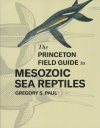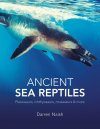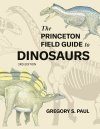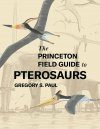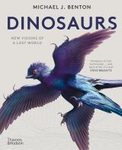By
Leon (NHBS Catalogue Editor)
3 May 2023
Written for Hardback

This is the second of a two-part dive into the world of extinct marine reptiles, following on from my review of Darren Naish's new book
Ancient Sea Reptiles. These two books were in the making simultaneously, with
The Princeton Field Guide to Mesozoic Sea Reptiles by independent palaeontologist and palaeoartist Gregory S. Paul making it into print four months before Naish's book. If a field guide to extinct creatures sounds unusual, think of it as an illustrated guide for the palaeo-enthusiast that revolves around Paul's signature skeletal reconstructions.
After two earlier books on dinosaurs (2016) and pterosaurs (2022), this book concludes Paul's informal trilogy of field guides covering the major Mesozoic reptile groups. The three books are in the same large format and feature the same colour scheme and design for the dustjacket, making them an imposing set on your bookshelf. I reviewed the pterosaur guide last year September and many of the observations I made there hold for this book as well. Structurally, the three guides follow the same format and some sections feature almost identical wording. As before, this book is divided into one half with an introduction and another half with the group and species accounts.
The introduction covers topics such as the history of research, the basics of dating fossils, a description of the Mesozoic world and who else lived in it, several mass extinction episodes, typical fossil localities, and three speculative zoology sections imagining what it would be like to travel back in time for a marine safari, what might have happened had the K–Pg extinction not come to pass, and how we might interact with the survivors today. The lion's share, however, is dedicated to their biology, and Paul provides a thorough introduction to numerous facets. Since marine reptiles are such a diverse bunch, the book deviates from the pterosaur guide and discusses the evolution and general anatomy of all of the major groups separately, making frequent comparisons to marine mammals and extant reptiles. Other sections look at locomotion, physiology, feeding and digestion, sensory biology, behaviour, growth and ageing, and the observed tendency to gigantism. Some of this material is quite detailed. Regarding metabolism, Paul first discusses various patterns observed in today's mammals, reptiles, and fish, before turning to extinct marine reptiles. The section on swimming goes into a fair amount of detail on hydrodynamics, though at nine pages it is of a more manageable length than the 22 pages he lavished on the aerodynamics of flight in the pterosaur guide. There are several comparisons to battleships and he betrays his interest in military hardware by likening the attack of a short-necked plesiosaur on a long-necked one as "a Luftwaffe Me-109E engaging a slower but harder-turning Hawker Hurricane Mk1 during the Battle of Britain in 1940" (p. 37). Perhaps more relevant is that, where Naish for example merely mentions that vintage palaeoart was wrong to show plesiosaurs holding their neck above water, Paul actually explains the mechanics of why this would not work.
The second half of the book discusses the groups and species. Naish went to great lengths in discussing the various macroevolutionary family trees that have been proposed over time. Paul is less committal here since there is no consensus and phylogenetic studies are too conflicting to his taste. He does arrange species in a phylogenetic order, with derived groups nested inside basal clades, but he uses "a degree of personal choice and judgment in arranging the groups", some of which reflect "my considered opinion, but most are arbitrary choices among a large array of competing research results" (p. 62). Though I can understand his choice to not discuss various proposed family trees, it would have been helpful to at least visually summarise his approach with a phylogenetic tree. Lacking this, navigating the species accounts is hard. These accounts are written as if this were a real field guide, with a staggering 435 telegram-style entries describing size and weight estimates, known fossil remains, anatomy, geological age, location and geological formation of fossils, habitat, lifestyle, and other notes. This is the reference section of the book, collecting facts without guiding narrative.
The icing on this marine reptile cake is of course the artwork, specifically the skeletal reconstructions. Paul's signature style of white bones on the black outline of a body is well-known and one he has been practising for decades. A noticeable difference with the pterosaur guide is that there are fewer full-body reconstructions. Where the pterosaur guide showed partial skeletons, it seems the fossil material available for marine reptiles is less complete or of poorer quality, meaning many more species entries illustrate only skulls or have no illustrations at all. Paul seems to have played it safe and only drawn full reconstructions when sufficient material has been reliably described. One explanation for this is probably that the taxonomic status of many species is doubtful or based on only a few fossil fragments. There are a handful of muscle studies, which he admits are speculative but based on sound anatomical principles, as well as life reconstructions. Lastly, there are some palaeoart pieces showing animals in their natural environment. I admit these were not quite my cup of tea; the combination of pencil-drawn animals placed on a photographic background is visually rather jarring (the pixelated bait ball on page 147 particularly stands out). Notably absent are photos of fossils.
So, how do the two books compare? When I reviewed Paul's pterosaur guide, I read it back-to-back with Mark Witton's pterosaur book. For this comparison, many of the same observations apply. Overall, Paul provides a broader range of biological background information than Naish does. His book is denser in data and covers all generally accepted taxa, something
Ancient Sea Reptiles did not aim for. The latter book is stronger in outlining the overall taxonomy, which I found useful given the complex evolutionary history of these groups. Furthermore, Naish's narrative style allows for more circumspection. Though Paul does indicate areas of contention, there is only so much nuance and detail you can convey in telegram-style entries. Overall, I would point new readers to
Ancient Sea Reptiles first, also given its fantastic illustrations. Then, if you want to read deeper into the details or need a reference work, Paul's book is a good follow-up; the two books complement each other very well and palaeontology buffs will likely want both.






